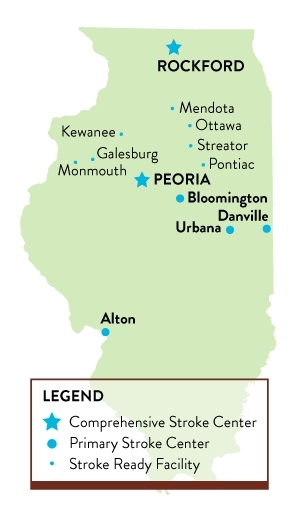During a stroke
If you suspect a stroke, call 9-1-1 immediately.
During a stroke, every minute counts. OSF HealthCare is committed to providing expert stroke care throughout our Ministry. Our multidisciplinary stroke teams are always prepared to provide fast, effective care the moment you arrive at any of our hospitals.
Stroke Treatments
Treatment options vary depending on the type of stroke. No matter which type of treatment is necessary, quick identification and treatment are always the most important factors for a good recovery.
- Intravenous t-PA - If the stroke symptoms started less than 4.5 hours ago, the doctors may administer a "clot busting" drug called t-PA (tissue plasminogen activator). This drug may be successful in dissolving the blockage in the brain artery.
- Intra-arterial interventions - If the stroke symptoms started less than 24 hours ago, highly trained doctors called neuro interventional surgeons can place a catheter in the brain arteries to look for the blockage or remove the clot from the artery with mechanical devices.
- Aneurysm clipping - Surgery that cuts off the blood flow into an aneurysm. Under general anesthesia, a section of the skull is removed and the aneurysm is located. A neurosurgeon uses a microscope to isolate the blood vessel with the aneurysm and places a small, metal, clothespin-like clip on the aneurysm, halting its blood supply. The clip remains in the person and prevents the risk of future bleeding from the aneurysm. The piece of the skull is then replaced and the scalp is closed.
- Endovascular aneurysm treatments - Using general anesthesia, a neurointerventional surgeon inserts a hollow plastic tube called a catheter into an artery (usually in the groin) and threads it using angiography through the body to the site of the aneurysm. Using a guided wire, special devices are used to block the aneurysm from circulation. An angiogram will be repeated several times throughout a person’s life to monitor the aneurysm.
Stroke Centers

While all OSF HealthCare hospitals and emergency centers are equipped to treat stroke, several of our facilities have earned designations for their ability to provide higher levels of care.
OSF HealthCare Saint Francis Medical Center in Peoria and OSF HealthCare Saint Anthony Medical Center in Rockford are designated as Comprehensive Stroke Centers. These facilities have:
- Ability to treat all types of strokes, with every known treatment 24 hours a day, seven days a week
- Highly trained, highly specialized care team
- Advanced imaging capabilities
Three OSF HealthCare hospitals have earned the distinction of Primary Stroke Center. They are:
- OSF HealthCare St. Joseph Medical Center in Bloomington
- OSF HealthCare Heart of Mary Medical Center in Urbana
- OSF HealthCare Sacred Heart Medical Center in Danville
Patients from any OSF stroke center benefit from access to our designated stroke centers.